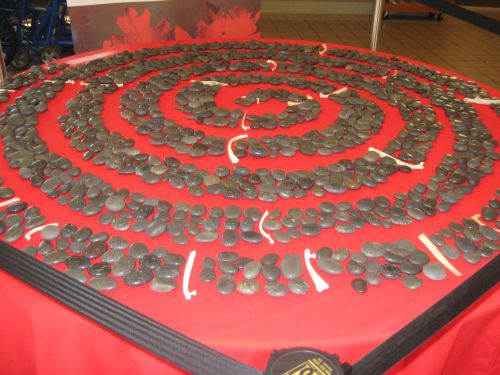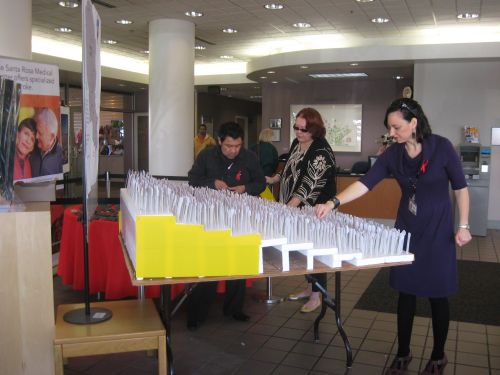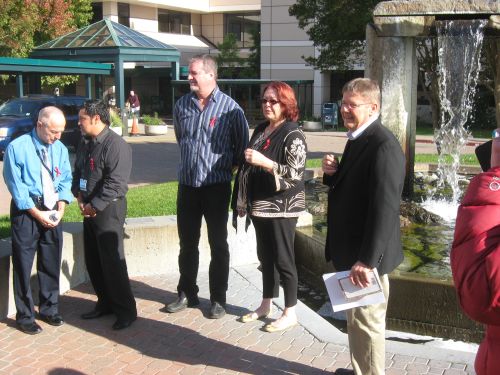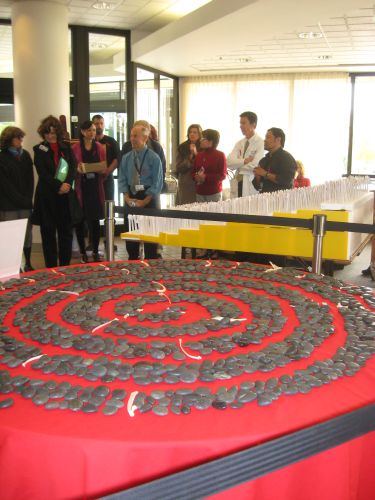On December 1st I walked up to the Kaiser hospital with my secretary. We would were going to help some members of the World AIDS Day committee set up their “Many Faces of AIDS” display in the hospital lobby. We put it next to the Circle of Stones, a powerful exhibit I hadn’t seen before. Each year, a group of artists who work with Face to Face, a local AIDS service agency, create a spiral. The center of the spiral represents the year 1983, when the first person in Sonoma County died of AIDS. As the spiral moves out, the years are broken up by pieces of bone. Each polished stone represents one life that was cut short by this disease.
In the late 1980s and early 90’s, the unbroken arc swings nearly around the whole circle. Those were the hard years. Fortunately, as we get to the outer rings, the intervals shorten. This represents breakthroughs in testing, prevention, and in treatment.
Since 1983, 1,169 people in my county have died from AIDS. Currently, 1,234 people are living with the disease. I liked that the “Faces of AIDS” display was next to the Circle of Stones. We don’t forget the people who have died; but we hope that the 1,234 represent a balance that is tipping toward life.
Setting up the Faces display was quite the situation comedy. Each of the polystyrene levels is numbered, so that anyone, even me, for instance, could assemble it. That part went swimmingly, once our promised table showed up. The corrugated paper edging, meant to cover up the rough styro ends, was not numbered. It was starting to seem like a Psychology Today experiment (“Let’s not tell the hapless subjects that they don’t have all the yellow corrugated paper pieces they need, and see if they figure it out!”). Finally we used what I call the Cake Decorating approach; you know, when you need to cover a goof, slather on the frosting? We stuck yellow crinkled paper everywhere and called it good.
Kaiser had a small ceremony. We met at the fountain outside the main entrance where Dale Webb, Kaiser’s chaplain, spoke for a few moments. He asked us to remember those who had passed away, and commented on the word “re-member;” we are bringing those who have passed away back as members of our community, spiritually. He had people say the names of those they wanted remembered. People called out names for about five minutes.
Dale talked about the good news and bad news. The good news is that worldwide the number of new cases is declining; that there is a new treatment for people who are HIV positive that shows great promise in reducing the spread of the disease; and the Pope made an intelligent, compassionate decision regarding condoms. There is bad news; more children are becoming infected; in America the cost of the new “wonder-drug” will probably be $1,000 a month, effectively making it unavailable to most people who need it. The United States can expect 56,000 new infections in 2011, according the National Institute of Health.
It’s a balance; tipping now toward the death, and now toward life.
Ramon, one of the World AIDS Day committee members and a hilarious human being, introduced speakers from Face to Face and from the committee itself. Then he introduced the musical interlude, calling the four Kaiser staff who sing and play instruments “the Kaiserettes.” They quickly informed us that they are also known as “Gypsy Wind.” Their vocals were outstanding, (especially her) and their plaintive three-point harmonies stood out and were much more melodic than their instrumentals. They have powerful vocals and should play to their strengths.
It was a quiet but joyful event and overall I was more happy than sad when I left to walk back to my office. The sky was tiled with soft white clouds, and a crow watched me go.






